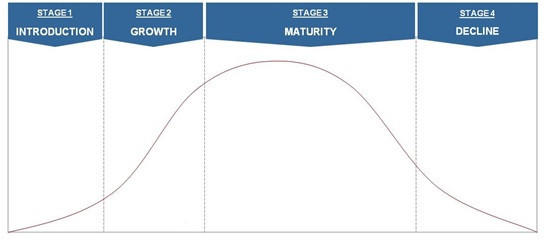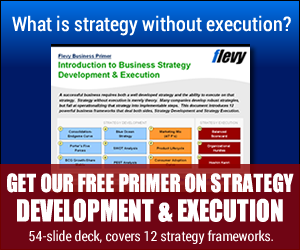The product life cycle framework is a simple and useful strategic model for product-oriented businesses.
There are four product life cycle stages in the Product Life Cycle model. If well understood and carefully mapped to your situation, the product life cycle can inform the selection of project management methodology and other critical approaches for managing a project. For example, the product life cycle can inform decisions as to project metrics and execution stage decisions – and even make a difference between project success and project failure.
Let’s take a look at how this traditional strategic framework has broader implications, particularly to project management, than usually thought.
What is the Product Life Cycle model?
The Product Life Cycle model is depicted in the graphic below. The vertical axis is volume sold and the horizontal axis is time.

The theory is that every product passes through these four life cycles: Introduction, Growth, Maturity, and Decline. The slope of the line and length of time in the various stages will vary.
Projects – such as building or changing production lines, or developing and servicing information systems – support the management of the company’s resources through these product life cycle phases. Before we dive into this too far, let’s take a deeper look into the meaning of each of the four product life cycle stages.
How the Framework Defines Four Product Life Cycle Stages
Here are the definitions of the four product life cycle stages.
- Introduction – This is the stage where the greatest investment is made, and usually for the least return in the short term. That also makes this potentially the riskiest stage. A company is making a bet during the Introduction phase that the product will be well-received, that the market will grow, and that the company will win a sufficiently large share of the market to recoup its investment and more. Ideally, the company will also work itself into a ‘power position in the market‘ where it can gain exceedingly attractive returns.
- Growth – In this stage, the market is growing for the product or service, and if the company has positioned its offering well, then sales and profits are increasing at least as fast as the market itself. Profits increase in the growth stage, allowing flexibility to build strengths in key areas that will pay off in the long run. The goal at this stage is to gain share and to leverage some benefits of one or more of the 7 powers – such as scale economies and branding – so that in the maturity phase the company can enjoy a protected position where profitability is high.
- Maturity – In the maturity phase, the market is no longer growing at the level it was in the Growth phase. By the Maturity phase, the market will have reached a competitive equilibrium, with significant barriers to entry, so it will be difficult for new entrants to enter the market. The company has hopefully built a strong position and at this stage needs to protect its barriers to entry – the ‘moats’ around the business – and invest more sparingly than in the Growth phase in order to maximize profits. The Maturity phase is a time to harvest the largest profits in the product life cycle.
- Decline – In the Decline phase, the market has not only ceased to grow but is shrinking and moving toward eventual extinction. This could be due to shifts that result in declining needs for the product or service, or better ways that customers may now have to get their job done. At this point, the company needs to limit investment, control costs, and even cut back on capabilities. This stage can still be profitable if planned and executed well, which is why it is so important to anticipate and recognize this stage.
These definitions show that the four stages of the product life cycle are very distinct. The distinctions are informative for planning and managing projects to identify the configuration of the product life cycle – how high does the curve go, and how long are the stages – in the area that your project is supporting.
This can be especially helpful for planning for financial and operational impacts of projects, as they will definitely be influenced by the stage in which they occur. For example, changing production capacity will have a different outcome depending upon the action taken and the stage in which it occurs.
How the Product Life Cycle Stages Inform PM methodology
Conditions are not static, and advantages gained in the marketplace usually temporal in nature. It can be extremely helpful to have the concept of product life cycle firmly in mind.
On your project, does the timetable match the needs of the market? The project is usually intended to seize a market opportunity. What is that opportunity, how long might it last, and how quickly do you need to achieve the meaningful results?
What stages are at work related to your project? If it is in the Introduction or Growth stage, your approach will likely be very different from what it might be in the Maturity or Decline phase. The urgency of getting your project to the finish line will be influenced by these things. In fact, the very definition and scope will be heavily influenced by the product life cycle stage.
In short, schedule, scope, and risks are heavily influenced by which of the four life cycle stages the project addresses. The natural solution in terms of project management methodologies is to shift from more waterfall oriented methods to agile methods.
Trends in Product Life Cycles
Product life cycles are generally becoming shorter – due to the pace of change, and in particular to the influence of digital technology. Indeed, planning cycles are collapsing and becoming more frequent, in sync with the shift from waterfall to increasingly agile methods for project management. The shorter the product life cycle, the shorter the project timeline needs to be. The whole trend toward shorter product life cycles parallels the trend of planning and execution cycles becoming shorter.
—————————————-
I recommend these strategy resources (paid link):
—————————————-
Because both strategic planning and project management cycles are generally tightening, it would seem that strategy and planning is in sync with the implementation. However, I would argue that the answer is in the details: it is project-specific.
The shift to shorter product life cycles is uneven and inconsistent. A company can easily have a portfolio of products that are each at different stages in the product life cycle. In addition, each product’s life cycle can have a different length (time). It make a huge difference whether your project supports a product with a long life cycle that is in Stage 3, Maturity, or one that has a short life cycle that is in Stage 1. This will have an impact on the work products and tasks that you identify, how you prioritize them, and how you plan to implement them. This will also shape how you engage with your stakeholders, and the types of metrics that you track with them.
Leverage the Four Product Life Cycle Stages for Project Success
The product life cycle framework is helpful in providing context that will influence how you plan a project. It is most important to identify which of the framework’s four product life cycle stages your project is supporting, and the expected timeline for passing through the stages. This will have a major impact on the expected return on investment for the project.
In considering whether to do a project in a product oriented business, consider the expected life cycle for the product, and identify where in the life cycle the project impacts and how long the stage and whole product life cycle will last. When planning and executing the project, identify metrics that are informed by the product life cycle that will help you best navigate product life cycle changes – and produce successful projects.
—————————————-
I recommend these PM templates (paid link):
—————————————-


Hey there,
I just finished reading your article on project management and the four product life cycle stages, and I couldn’t help but drop a comment to express how much I enjoyed it. It’s evident that you have a deep understanding of the subject matter, and your writing style makes complex concepts feel so approachable.
Your breakdown of the four stages of the product life cycle and how they tie into project management was incredibly insightful. I work in project management myself, and your article provided a fresh perspective that I hadn’t considered before. It’s clear that effective project management plays a critical role in ensuring the success of products at each stage of their life cycle. Your practical tips and examples were also a great addition. They help bridge the gap between theory and real-world application.
What I appreciate most is how you’ve made this topic engaging and relatable. The way you’ve woven in anecdotes and real-world examples helps the reader connect with the material. It’s not often you find such a perfect balance between informative and enjoyable. Kudos on a well-written and informative piece! Looking forward to reading more from you in the future. Keep up the fantastic work.
For more information please visit the website: https://pmoglobalinstitute.org/what-is-project-life-cycle/
Thank you so much for your kind comments! I have been to the pmoglobalinstitute.org website and find it also to be an excellent resource!